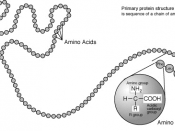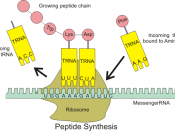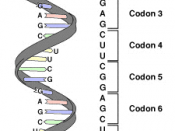Unlike the other biological molecules, proteins are the most complex in terms of its formation from its monomer as well as the different forms it can take when fully formed (primary, secondary, tertiary and quaternary).The process of its formation begins in the nucleus and ends in the cytoplasm.
Transcription is the first step in protein synthesis. This involves the unwinding of the DNA molecule in the nucleus followed by the formation of mRNA by using one of the polynucleotide chains as a template for complementary base pairing according to the rules of RNA-DNA base pairing. Free nucleotides join to the mRNA strand under the influence of RNA polymerase. When this process is completed, the DNA double helix rejoins and the newly formed mRNA leaves the nucleus through the nuclear pores.
In the cytoplasm, the mRNA attaches to ribosomes. Another type of RNA, transfer RNA (tRNA) brings amino acids to the ribosomes, a process catalysed by the enzyme, aminoacyl-tRNA synthetase.
Each tRNA molecule is specific and so one tRNA molecule can bind to only one type of amino acid. For each triplet of bases on the mRNA molecule, (a codon), there is a corresponding anticodon on one of the aminoacyl-tRNA molecules. Therefore the particular sequence of amino acids formed is dictated by the sequence of bases on the mRNA strand. As each amino acid is brought to the ribosome, it is linked together to the next amino acid by peptide bond. The polypeptide chain continues to extend until a stop codon is reached, (UAG, UGA or UAA).
At this point the protein now with its primary structure leaves the ribosome and translation is complete. As the protein leaves it may immediately assume its secondary, tertiary or quaternary structures or if the ribosome is attached to the endoplasmic reticulum, the protein may...


